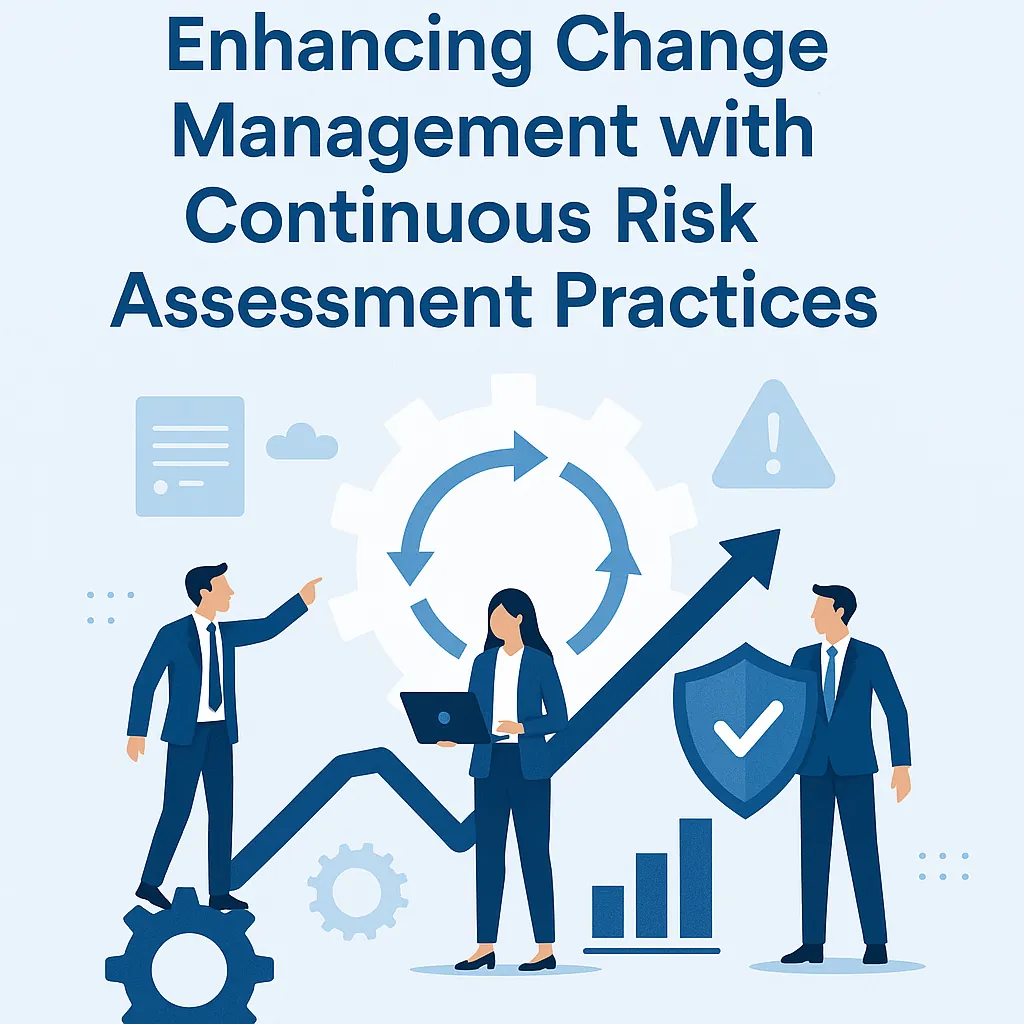Introduction
Change management is a critical discipline that focuses on preparing, supporting, and helping individuals, teams, and organizations in making organizational change. It is significant because it ensures that changes are implemented smoothly and successfully, minimizing resistance and maximizing engagement among stakeholders. Effective change management not only facilitates the transition but also enhances the overall success of projects by aligning the change with the strategic goals of the organization.
At the heart of successful change management lies risk assessment, a systematic process of identifying, analyzing, and responding to potential risks that could hinder the success of change initiatives. This process is essential for understanding the uncertainties associated with changes and for developing strategies to mitigate those risks. By conducting thorough risk assessments, project managers can prioritize risks based on their likelihood and potential impact, allowing for informed decision-making and proactive management of challenges that may arise during the change process.
In today’s fast-paced project environments, the need for continuous risk assessment has become increasingly apparent. Rapid technological advancements, shifting market dynamics, and evolving stakeholder expectations necessitate a more agile approach to change management. Continuous risk assessment enables project managers to remain vigilant and responsive to emerging risks throughout the lifecycle of a change initiative. By integrating ongoing risk evaluation into their change management practices, project managers can better anticipate challenges, adapt strategies in real-time, and ultimately enhance the likelihood of successful change implementation. This proactive approach not only safeguards the project’s objectives but also fosters a culture of resilience and adaptability within the organization.
As we delve deeper into the practices of continuous risk assessment, we will explore its methodologies, tools, and best practices that can empower project managers to navigate the complexities of change management effectively.
Understanding Risk Assessment in Change Management
When navigating change initiatives, risk assessment plays a pivotal role. It serves as a systematic approach to identifying, analyzing, and evaluating potential risks that could hinder the success of a change initiative. Here’s a closer look at the components of risk assessment and its significance in change management.
Components of Risk Assessment
- Risk Identification: This is the foundational step where potential risks are documented. It involves recognizing barriers that may prevent the change initiative from achieving its objectives. Effective identification requires a thorough understanding of the change initiative’s goals and the context in which it operates [6][4].
- Risk Analysis: Once risks are identified, the next step is to analyze them. This involves categorizing the risks based on their likelihood of occurrence and potential impact on the project. Analyzing risks helps project managers prioritize which risks need immediate attention and which can be monitored over time [7].
- Risk Evaluation: This component assesses the significance of the identified risks in relation to the project’s objectives. It helps in determining the acceptable level of risk and informs decision-making regarding risk mitigation strategies. Evaluating risks ensures that project managers are prepared to respond effectively to challenges as they arise [6][8].
Contribution to Successful Change Management
Continuous risk assessment is integral to successful change management for several reasons:
- Proactive Management: By regularly assessing risks, project managers can anticipate potential challenges and implement strategies to mitigate them before they escalate. This proactive approach reduces the likelihood of project delays and cost overruns [15].
- Enhanced Decision-Making: A thorough understanding of risks allows project managers to make informed decisions regarding resource allocation, stakeholder engagement, and change implementation strategies. This leads to more effective management of change initiatives [12].
- Stakeholder Confidence: Regular risk assessments demonstrate to stakeholders that the project team is vigilant and prepared to handle uncertainties. This builds trust and confidence among stakeholders, which is crucial for the success of any change initiative [15].
Common Risks in Change Initiatives
Change initiatives often encounter a variety of risks, including:
- Cultural Resistance: Organizational culture can significantly impact how individuals respond to change. Resistance from employees can undermine the success of change initiatives, making cultural assessment a critical component of risk management [3].
- Inadequate Communication: Poor communication can lead to misunderstandings and misalignment among team members and stakeholders. Ensuring clear and consistent communication is essential to mitigate this risk [12].
- Resource Constraints: Limited resources, whether financial, human, or technological, can hinder the implementation of change initiatives. Identifying and planning for these constraints is vital for successful change management [4].
- Lack of Change Readiness: Organizations may not be adequately prepared for significant changes, leading to a lack of buy-in from employees. Conducting a change readiness assessment can help identify gaps in preparedness and inform strategies to address them [5].
The Need for Continuous Risk Assessment
As projects progress, the risks associated with them are not static; they shift and transform in response to various internal and external factors. This dynamic nature of projects underscores the necessity for continuous risk assessment practices, which can significantly enhance the effectiveness of change management efforts.
- Dynamic Nature of Projects: Projects are influenced by a multitude of variables, including stakeholder engagement, market conditions, and organizational changes. As these factors evolve, so too do the risks that can impact project success. For instance, a change initiative may initially face resistance from employees, but as communication improves and engagement strategies are implemented, new risks may emerge, such as shifts in team dynamics or resource allocation challenges. Recognizing that risks are not static but rather fluid is crucial for project managers aiming to navigate the complexities of change effectively [1].
- Limitations of Traditional Risk Assessments: Traditional risk assessments often occur at the project’s outset, providing a snapshot of potential risks at a single point in time. This approach can lead to significant oversights, as it fails to account for the evolving nature of risks throughout the project lifecycle. For example, a risk identified during the initial planning phase may become irrelevant or transform into a different risk as the project progresses. Consequently, relying solely on one-time assessments can leave project managers ill-prepared to address emerging challenges, ultimately jeopardizing the success of change initiatives [2].
- Enhancing Responsiveness and Adaptability: Implementing continuous risk assessment practices allows project managers to remain agile and responsive to changes as they occur. By regularly evaluating risks, teams can identify new threats and opportunities, enabling them to adapt their strategies accordingly. This proactive approach not only mitigates potential issues before they escalate but also fosters a culture of resilience within the organization. For instance, ongoing assessments can facilitate timely adjustments to project plans, resource allocation, and stakeholder engagement strategies, ensuring that the change initiative remains aligned with organizational goals and responsive to stakeholder needs [3].
Key Practices for Continuous Risk Assessment
Implementing continuous risk assessment in change management is essential for long-term project success. Here are some practical strategies and methodologies that project managers can adopt to enhance their change initiatives:
- Establish a Risk Management Framework: A robust risk management framework is the foundation for continuous assessment. This framework should clearly define the processes for identifying, analyzing, and responding to risks throughout the change initiative. It should also align with the organization’s overall risk tolerance levels, ensuring that the approach is tailored to the specific needs of the project and its stakeholders [11].
- Implement Regular Risk Reviews and Updates: Integrating regular risk reviews into the change management process is crucial. These reviews should be scheduled at key project milestones or phases, allowing teams to reassess risks in light of new information or changes in the project environment. This proactive approach helps in identifying emerging risks early and adjusting strategies accordingly [1][9].
- Utilize Tools and Technologies for Real-Time Risk Tracking: Leveraging technology can significantly enhance risk assessment practices. Tools that provide real-time tracking and reporting of risks enable project managers to monitor risk status continuously. This can include risk management software that integrates with project management tools, allowing for seamless updates and visibility across the team [5][8].
- Encourage a Culture of Open Communication: Fostering an environment where team members feel comfortable discussing risks is vital for effective risk management. Encouraging open communication helps in surfacing potential risks that may not be immediately apparent. Regular team meetings and brainstorming sessions can facilitate this dialogue, ensuring that everyone is engaged in the risk assessment process [4][7].
By implementing these key practices, project managers can create a dynamic and responsive risk management approach that supports ongoing change initiatives, ultimately leading to more successful project outcomes.
Integrating Continuous Risk Assessment into Change Management Processes
The ability to adapt to change is crucial for success. Continuous risk assessment plays a vital role in enhancing change management practices, ensuring that organizations can navigate uncertainties effectively. This section outlines how to embed continuous risk assessment into existing change management frameworks, focusing on key integration points, stakeholder involvement, and real-world examples.
Mapping Out the Integration of Risk Assessment
To effectively integrate continuous risk assessment into change management, it is essential to map out its application across various phases of the change process:
- Initiation Phase: During the initial stages, organizations should conduct a preliminary risk assessment to identify potential challenges and opportunities associated with the proposed change. This involves gathering data through brainstorming sessions, surveys, and SWOT analysis to understand the landscape better [4].
- Planning Phase: As the change initiative is planned, risk assessment should be prioritized. Engaging a member of the operations management team in the change committee can ensure that risk considerations are embedded in project planning [2]. This phase should also include the development of a change template that outlines risk assessment steps and necessary approvals [8].
- Execution Phase: Continuous monitoring of risks during the execution of change initiatives is crucial. Organizations should utilize data-driven approaches to track metrics that link changes to incidents, allowing for real-time adjustments to the change management strategy [3]. Regular audits and user feedback can also help identify areas needing immediate attention [6].
- Review Phase: After implementation, organizations should conduct a thorough review of the change process, assessing the effectiveness of the risk management strategies employed. This reflection can inform future initiatives and foster a culture of continuous improvement [11].
The Role of Stakeholders
Stakeholders play a pivotal role in the continuous risk assessment process. Their involvement ensures that diverse perspectives are considered, enhancing the robustness of the risk management strategy. Key stakeholder roles include:
- Change Leaders: They are responsible for championing the change initiative and ensuring that risk assessment is prioritized throughout the process. Their leadership can drive engagement and commitment from other stakeholders.
- Operations Management: By including operations management in the change committee, organizations can leverage their expertise in identifying operational risks and developing mitigation strategies [2].
- End Users: Gathering feedback from end users is essential for understanding the practical implications of changes. Their insights can help identify unforeseen risks and areas for improvement [6].
Case Studies of Successful Integration
Several organizations have successfully integrated continuous risk assessment into their change management processes, demonstrating the effectiveness of this approach:
- Company A: A technology firm implemented a continuous risk assessment framework during a major software upgrade. By involving cross-functional teams in regular risk reviews, they identified potential user resistance early on, allowing them to address concerns proactively. This led to a smoother transition and higher user satisfaction.
- Company B: A manufacturing company adopted a data-driven risk assessment approach for its operational changes. By tracking key performance indicators and linking them to change initiatives, they were able to adapt their strategies in real-time, significantly reducing downtime and improving overall efficiency.
- Company C: A healthcare organization integrated continuous risk assessment into its change management by conducting regular audits and soliciting user feedback. This approach not only identified areas needing change but also fostered a culture of transparency and collaboration, ultimately enhancing the organization’s resilience to change [11].
Challenges and Solutions in Implementing Continuous Risk Assessment
Implementing continuous risk assessment practices in change management is essential for project managers aiming to navigate the complexities of ongoing change initiatives. However, several challenges can impede this process. Below are some common obstacles along with strategies to overcome them, emphasizing the importance of leadership support and stakeholder engagement.
Common Challenges
- Resistance to Change: Change initiatives often face pushback from team members who are accustomed to existing processes. This resistance can stem from fear of the unknown or a lack of understanding of the benefits of the change.
- Resource Allocation: Limited funding and time constraints can significantly impact the effectiveness of risk assessment processes. Insufficient financial resources may hinder the implementation of comprehensive risk assessment measures, making it difficult to allocate necessary resources for ongoing assessments [13].
- Data Management: Accurate risk assessment relies heavily on the availability and quality of data. Project managers may struggle with insufficient historical data, especially when dealing with emerging technologies or unprecedented events, which complicates the analysis of trends and patterns [1].
Strategies to Overcome Challenges
- Training and Development: Providing training sessions for team members can help mitigate resistance to change. Educating staff about the benefits of continuous risk assessment and how it can enhance project outcomes fosters a culture of acceptance and adaptability.
- Utilizing Change Management Tools: Implementing effective change management tools can streamline the risk assessment process. These tools can help in tracking risks, documenting changes, and facilitating communication among stakeholders, thereby improving overall project management efficiency.
- Embedding Risk Management into Strategic Planning: Continuous improvement in the risk assessment process can be achieved by integrating risk management into strategic planning and operational processes. This approach ensures that risk considerations are part of the decision-making framework, allowing for proactive rather than reactive management [11].
Importance of Leadership Support and Stakeholder Engagement
- Leadership Support: Strong leadership is crucial for the successful implementation of continuous risk assessment practices. Leaders should model risk-conscious behavior by making informed decisions based on risk assessments and actively promoting a risk-aware culture within the organization [11].
- Stakeholder Engagement: Engaging stakeholders throughout the change process is vital. By involving them in discussions about risks and changes, project managers can foster a sense of ownership and collaboration, which can significantly reduce resistance and enhance the effectiveness of risk management strategies.
Measuring the Effectiveness of Continuous Risk Assessment
When navigating change initiatives, the implementation of continuous risk assessment practices is crucial. This section will delve into how to measure the effectiveness of these practices, focusing on key performance indicators (KPIs), the impact on project outcomes, and methods for ongoing evaluation and improvement.
Defining Key Performance Indicators (KPIs) for Risk Management Effectiveness
To effectively measure the success of continuous risk assessment, it is essential to establish clear KPIs. These indicators can include:
- Frequency of Risk Assessments: Track how often risk assessments are conducted. Regular assessments indicate a proactive approach to risk management [1].
- Risk Mitigation Success Rate: Measure the percentage of identified risks that have been successfully mitigated or managed. A higher rate suggests effective risk management practices [9].
- Stakeholder Engagement Levels: Evaluate the involvement of stakeholders in the risk assessment process. Higher engagement often correlates with better identification and management of risks [4].
- Response Time to Risks: Monitor the time taken to respond to identified risks. Quicker response times can indicate a more agile and effective risk management process [7].
Impact of Continuous Risk Assessment on Project Outcomes and Stakeholder Satisfaction
Continuous risk assessment significantly influences project outcomes and stakeholder satisfaction. Key impacts include:
- Improved Project Success Rates: By regularly identifying and addressing risks, projects are more likely to meet their objectives and deadlines, leading to higher success rates [11].
- Enhanced Stakeholder Trust: When stakeholders see that risks are being actively managed, their confidence in the project increases, fostering a more collaborative environment [11].
- Increased Adaptability: Continuous assessment allows teams to adapt to changes and unforeseen challenges more effectively, ensuring that projects remain on track despite evolving circumstances [3].
Methods for Ongoing Evaluation and Improvement of Risk Assessment Practices
To ensure that risk assessment practices remain effective, project managers should consider the following methods for ongoing evaluation and improvement:
- Regular Review of KPIs: Establish a routine for reviewing the defined KPIs to assess their relevance and effectiveness. Adjust them as necessary to align with project goals and changing environments [1].
- Stakeholder Feedback Mechanisms: Implement feedback loops with stakeholders to gather insights on the risk management process. This can help identify areas for improvement and enhance stakeholder satisfaction [4].
- Data-Driven Analysis: Utilize data analytics to scrutinize risk management outcomes. This approach allows for a more accurate quantification of risks and can inform better decision-making [5].
- Training and Development: Invest in training for project teams on the latest risk management techniques and tools. Continuous learning can enhance the team’s ability to identify and manage risks effectively [8].
By focusing on these key areas, project managers can enhance their change management processes through effective continuous risk assessment practices, ultimately leading to more successful project outcomes and greater stakeholder satisfaction.
Conclusion
When navigating the complexities of change initiatives, the integration of continuous risk assessment practices is paramount. This approach not only enhances the likelihood of success but also equips project managers with the tools necessary to identify and mitigate potential threats throughout the change process.
- Importance of Continuous Risk Assessment: Continuous risk assessment allows project managers to proactively identify, assess, and address risks that may arise during the lifecycle of a change initiative. By regularly evaluating the impact of changes on stakeholders and the organization, managers can make informed decisions that align with project objectives and minimize disruptions [1][6]. This ongoing vigilance ensures that risks are not only acknowledged but also managed effectively, fostering a culture of adaptability and resilience.
- Encouragement for Adoption: For long-term success, it is essential for project managers to embrace continuous risk assessment as a core component of their change management strategy. By doing so, they can enhance their ability to navigate uncertainty and complexity, ultimately leading to more successful project outcomes. Implementing structured risk management processes, such as utilizing risk assessment tools and engaging team members in identifying potential risks, can significantly improve the effectiveness of change initiatives [4][15].
In summary, the commitment to continuous risk assessment is not merely a best practice; it is a vital strategy that empowers project managers to lead successful change initiatives with confidence and foresight. By prioritizing this approach, project managers can ensure that they are well-equipped to handle the challenges that come with change, ultimately driving their projects toward success.
Find out more about Shaun Stoltz https://www.shaunstoltz.com/about/.
This post was written by an AI and reviewed/edited by a human.



